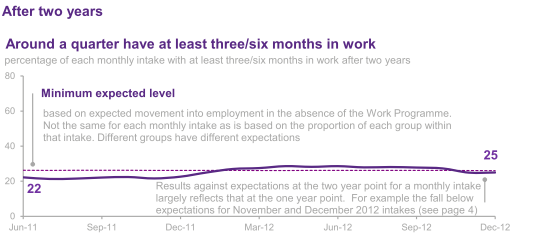There have been several statistical announcements in the course of the last week, generally missed because of the budget. One set is concerned with the Work Programme. 70% of claimants who have been through the Work Programme return to Jobcentre Plus. The figures for claimants who have found and retained work have increased to 25%; but the figure for comparison is that 26% of the claimants on the previous scheme, the Flexible New Deal, did so. This graph seems particularly revealing. The dotted line shows what might be expected if nothing at all was done. The Work Programme has done no better.
Iain Duncan Smith has announced, characteristically, that his critics have been proved wrong. “This isn’t just about numbers.” Quite.
Another set of figures released on Wednesday tells us that there are now 40,100 claimants of Universal Credit (the figure is dated 12th February). I pointed out in January that as 80% of jobless claimants return to work within a year, it wasn’t possible to enrol enough UC claimants to make the scheme irreversible before May. The cheapest and simplest option for any new government will be to scrap it.
